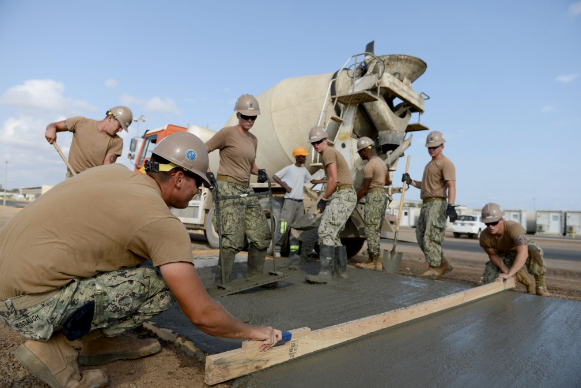With the official motto of CAN DO, the United States Navy Seabees were established over 77 years ago following the surprise Japanese attack on Pearl Harbor, on December 7, 1941, which sparked the United States’ entry into World War II.
The Seabees served as replacements for over 70,000 civilians working overseas for private civilian construction companies.
Unlike their civilian predecessors, Seabees could resist and engage in military combat if attacked without being classified as guerrillas.
Resistance to enemy attack as a civilian was illegal under International Law and subjected the civilians to summary execution.
Related Article – Army Horizontal Construction Engineer (MOS 12N): Career Details
Their nickname, Seabees, is a homophone of Construction Battalions, or “C.B.”
The seven original “official” rates of the Navy Seabees established in 1948 are still in use today:
No other rates have been added to the Seabees since the original seven.
It is the Seabees who form the United States Navy’s Naval Construction Force (NCF).
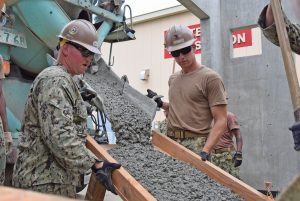
Related Article – Army Bridge Crewman (MOS 12C)
Navy Seabees can expect to be deployed to units such as Naval Construction Groups, Naval Construction Battalions, Naval Construction Regiments, Construction Battalion Maintenance Units, and Underwater Construction Teams.
A full list of these can be found on the Official Website of the United States Naval Construction Force.
Enlisted members of the Seabees assigned to qualifying units are authorized to wear the coveted SCW (Seabees Combat Warfare Enlisted) Insignia.
Builder (BU)
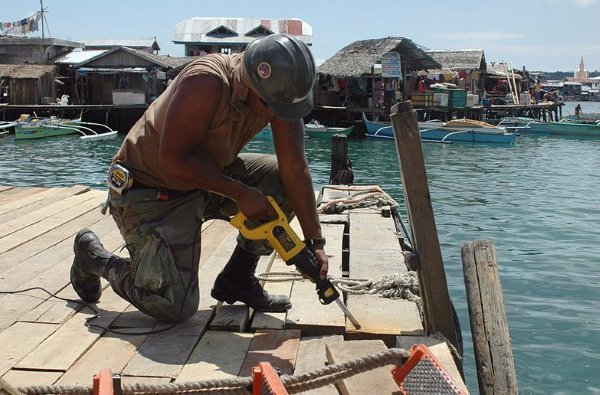
The largest segment of the Seabees are the Navy Builders (BU).
Builders work as cabinet makers, painters, roofers, plasterers, carpenters, concrete finishers, carpenters, bricklayers, and masons.
Specifically, Navy Builders:
- Install interior finish work (i.e., paneling, ceramic tile walls, sheetrock).
- Install trim, ceiling tile, floor tile, and millwork.
- Build and repair masonry, concrete, wood, and steel structures.
- Mix, place, and finish concrete.
- Build forms for concrete construction.
- Make estimates of labor, equipment, and material requirements.
- Read and interpret blueprints.
- Prepare sketches for projects.
- Operate cabinet-making, carpentry, tool, and equipment repair shops.
- Build bridges, wharves, and other heavy timber structures.
- Operate portable concrete mixers, concrete batch plants, and other concrete finishing tools and equipment.
The minimum ASVAB scores to qualify for the BU rating are AR+MC+AS=136 or VE+AR+MK+AO=197.
Navy Builder Class “A” Technical School is in Gulfport, Mississippi, and is approximately 10 weeks long.
Approximately 1,600 men and women serve as BUs in the United States Navy.
Related Article – Navy Jobs List: A List Of All 71 Ratings In The Navy
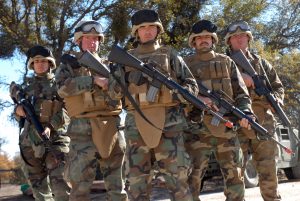
Construction Electrician (CE)
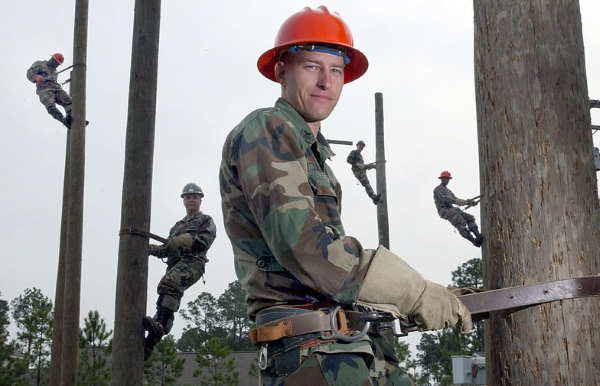
Navy Construction Electricians (CE) maintain, operate, and build electrical distribution systems and power production facilities for Naval Installations worldwide.
Specifically, Navy Construction Electricians:
- Work with electric motors, solenoids, switches, relays, and batteries.
- Operate electrical generators.
- Read and interpret blueprints as well as prepare sketches for projects.
- Estimate labor, material, and equipment requirements for projects.
- Install, repair, and maintain interior wiring for electrical and lighting equipment.
- Lay and splice cables, string wires, install distribution panels and transformers, and erect poles.
- Maintain, repair, and install high and low-voltage electrical power distribution networks and telephone systems (both underground and overhead).
- Install, repair, and maintain fire alarms, public address systems, inter-office and telephone switchboard systems, and street lighting.
The minimum ASVAB scores to qualify for the CE rating are AR+MK+EI+GS=201.
The 20-week-long Navy Construction Electrician Class “A” Technical School is located at Shepard Air Force Base, Texas.
Approximately 1,000 men and women serve as CEs in the United States Navy.
Related Article – Electricians Mate (EM): Career Details
Construction Mechanic (CM)
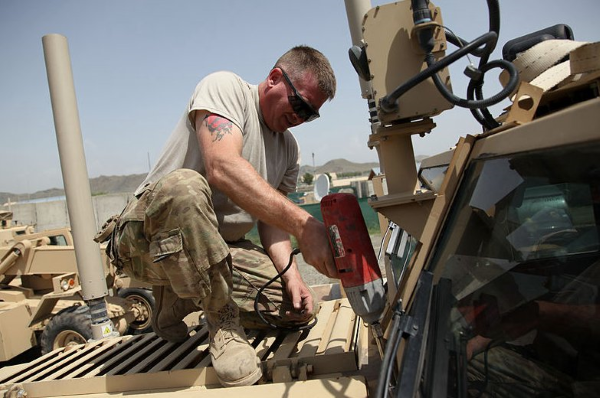
Navy Construction Mechanics (CM) maintain and repair automotive and heavy construction equipment for the US Navy.
This includes backhoes, tactical vehicles, pile drivers, cranes, rollers, bulldozers dump trucks, and buses.
CMs must also prepare detailed cost control data and maintenance requirements estimates, as well as acquire needed parts.
Specifically, Navy Construction Mechanics:
- Repair and maintain frames, bodies, and chassis.
- Work with jacking and hoisting equipment, measuring instruments, gauges, meters, and power tools.
- Lubricate equipment.
- Repair and adjust electrical, hydraulic, steering, ignition, and fuel systems.
- Troubleshoot and diagnose equipment failures.
- Maintain and repair gasoline and diesel engines.
- Repair and maintain batteries, brakes, valves, and tires.
- Perform shop management functions like spare parts inventory control and maintenance scheduling.
- Make estimates.
The minimum ASVAB scores to qualify for the CM rating are AR+MC+AS=162.
Navy Construction Mechanic Class “A” Technical School is located in Port Hueneme, California, and is approximately 16 weeks in duration.
Approximately 1,450 Seabees serve as CMs in the United States Navy.
Related Article – Marine Corps Mechanics (MOS 3521)
Engineering Aide (EA)
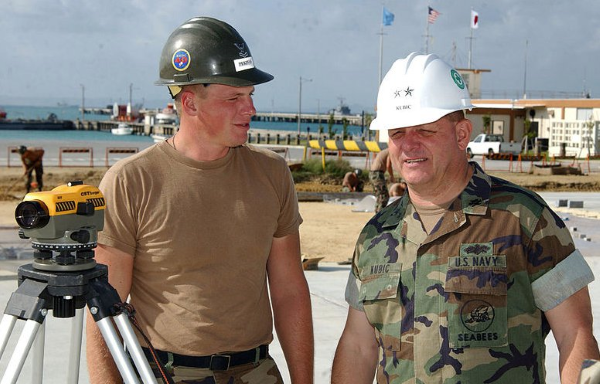
Navy Engineering Aides (EA) work with Navy Construction Engineers (CE) by assisting in the development of final construction plans.
EAs also prepare maps, sketches, blueprints, and drawings, conduct land surveys, perform quality assurance tests on construction materials such as concrete, asphalt, and soils, estimate costs, and perform various other engineering technician functions.
Specifically, Navy Engineering Aides:
- Prepare mechanical, architectural, electrical, and civil sketches and drawings.
- Conduct asphalt, soil, and concrete tests.
- Design drainage and grading systems.
- Conduct location surveys for airfields, ditches, pipelines, roads, buildings, waterfront construction, and drainage structures.
- Prepare triangulation, topographic, and hydrographic maps and drawings.
- Compute the necessary volume of bulk materials (earthwork, bituminous mixtures, and concrete) from specifications and drawings.
- Layout all types of construction work.
- Operate and maintain numerous types of laboratory and precision surveying equipment and instruments.
- Read and interpret blueprints for projects.
- Prepare sketches for projects.
- Make estimates of labor, equipment, and material requirements.
- Prepare network charts, graphs, and analyses.
- Conduct quality control inspections for construction projects.
The minimum ASVAB scores to qualify for the EA rating are AR+2MK+GS=207.
Navy Engineering Aide Class “A” Technical School is located in Fort Leonard Wood, Missouri, and is 15 weeks long.
The smallest segment of the Seabees are Engineering Aides, with only about 170 Seabees currently serving in the United States Navy.
Related Article – US Air Force Engineering (3E5X1): Career Details
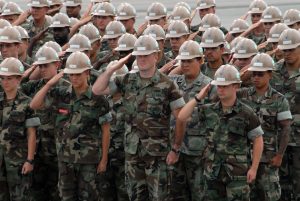
Equipment Operator (EO)
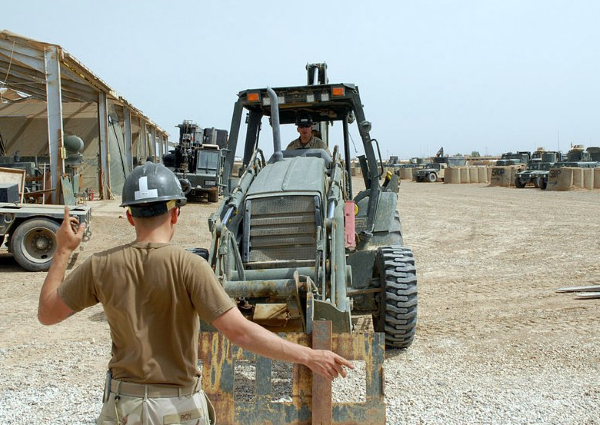
Related Article – US Navy Ships Serviceman (SH): Career Details
Navy Equipment Operators (EO) operate construction and heavy transportation equipment.
These include asphalt equipment, bulldozers, graders, cranes, forklifts, backhoes, and trucks.
Specifically, Navy Equipment Operators:
- Work as a member of a crane crew to rig cable assemblies as well as change attachments for various pile-driving and lifting operations.
- Operate a diverse variety of self-propelled, heavy-duty construction equipment for numerous projects including roadway construction, pier construction, excavation, grading, and building construction.
- Perform minor maintenance on equipment to help ensure efficient, safe operation.
- Prepare operational reports on equipment.
- Operate well-drilling and rock-crushing equipment.
- Work as blasters for construction projects
- Read and interpret blueprints
- Prepare sketches for projects.
- Estimate material, labor, and equipment requirements.
The minimum ASVAB scores to qualify for the EO rating are AR+MC+AS=136.
The 11-week-long Navy Equipment Operators Class “A” Technical School is located in Fort Leonard Wood, Missouri.
Approximately 1,200 men and women serve as EOs in the United States Navy.
Related Article – Army Battle Management System Operator (MOS 14G): Career Details
Steelworker (SW)
Navy Steelworkers (SW) operate and rig special equipment used to build metal structures. They fabricate and lay out sheet metal and structural steel.
They also work with concrete-reinforcing steel bars.
SWs also perform cutting and welding operations, use special tools, and read blueprints.
Specifically, Navy Steelworkers:
- Make estimates of equipment, materials, and labor requirements.
- Erect tanks, steel bridges, towers, buildings, and pre-engineered structures.
- Install, fabricate, and lay out sheet metal systems and assemblies.
- Prepare sketches for projects.
- Read and interpret blueprints.
- Reinforce and install steel in concrete structures.
- Fabricate, erect, install, fit, weld, and bolt the built-up sections, structural steel shapes, and plates used in heavy construction.
- Perform metal cutting and welding operations.
The minimum ASVAB scores to qualify for the SW rating are AR+MC+AS=136.
Navy Steelworker Class “A” Technical School is 11 weeks long and located in Gulfport, Mississippi.
There are approximately 560 SWs in today’s Navy.
Related Article: 5 Best Navy Combat Jobs
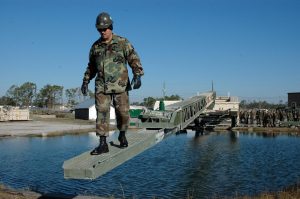
Utilitiesman (UT)
Navy Utilitiesmen (UT) work with heating, steam-compressed air, plumbing, storage, fuel, and distribution systems for the US Navy.
Their duties include distribution and water treatment systems, refrigeration and air conditioning equipment, and disposal and sewage collection facilities at Navy installations worldwide.
Specifically, Navy Utilitiesman:
- Maintain and install systems that require pipe-fitting and plumbing skills.
- Maintain and operate wastewater and water systems and treatment plants.
- Repair, install, and operate ventilation, air conditioning, heating, and piping systems.
- Make estimates.
- Read and interpret blueprints.
- Prepare sketches for projects.
- Identify and conduct procedures to minimize or limit the adverse effects of environmental pollution.
The minimum ASVAB scores to qualify for the UT rating are AR+MK+EI+GS=205 or AR+AS+MK=145.
Navy Utilitiesman Class “A” Technical School is 13 weeks long and located at NCTC Sheppard Air Force Base, Texas.
Approximately 750 men and women serve as UTs in the United States Navy.
Related Article – Air Force Materiel Management (2S0X1): Career Profile
All Seabee rates require a minimum five-year enlistment.
The Sea/Shore rotation varies by the Seabee’s rate.
Interested individuals should refer to official Navy websites or contact their local US Navy recruiter for specific sea/shore rotation information for individual rates.
Current and past Seabees give their careers overwhelmingly positive reviews on the career website www.indeed.com.
Related Article: 41 Questions To Ask A Military Recruiter
A few of these reviews are featured:

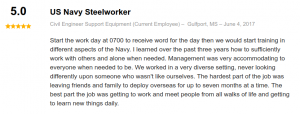


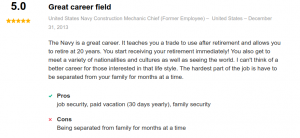
Related Article: 10 Best Jobs In The Navy For Civilian Life
Quick Frequently Asked Questions
What do Seabees do in the Navy?
Navy Seabees are the construction force of the Navy, and they work as builders, finishers, masons, electricians, mechanics, and heavy equipment operators in support of the Navy mission.
Do Navy Seabees see combat?
Seabee construction projects serve both combat and non-combat missions. They do carry weapons that allow them to engage the enemy at greater distances than standard-issue weapons.
Where do Seabees get stationed?
Port Hueneme and Gulfport are primary hubs for the Seabees, while shore duty can see them working on base infrastructure at many U.S. and overseas bases.
What weapons do Seabees use?
Seabees use M240B and Mk2 .50 caliber machine guns with ranges up to 1,800 meters.
How do I become a Seabee?
To become a Seabee, you’ll need the minimum combined ASVAB score in n Arithmetic Reasoning, Mechanical Comprehension, and Auto and Shop Information for that rating. You’ll need to enlist for 60 months and attend boot camp and then A School. The length of A School varies by specialty.
Conclusion
There are 13,815 total Seabees serving in the US Navy today, including 7,000 active duty members, and 6,927 Navy Reservists.
The Navy Seabees are highly-regarded and much respected in the United States Navy.
Civilian career opportunities for Navy Seabees are unlimited, with former Seabees being much sought-after employees by civilian construction companies.
It’s doubtful that a former Seabee ever needs worry about employment options.
A career as a Navy Seabee is sure to be a challenging and rewarding career for any man or woman considering joining the United States Navy.
With adventurous travel, respect of your fellow sailors, and a chance to make a real difference in war or in peace, it is an opportunity well worth consideration.
References
Indeed.com Navy Seabee Reviews
Official Website of the United States Naval Construction Force
Official Navy Page for Navy Seabees
Navy COOL Summary For Builder (BU)
Navy COOL Summary For Construction Electrician (CE)
Navy COOL Summary for Construction Mechanic (CM)
Navy COOL Summary For Engineering Aide (EA)
Navy COOL Summary For Equipment Operator (EO)
Navy COOL Summary For Steelworker (SW)
Navy COOL Summary For Utilitiesman (UT)
- Gas Turbine Systems Technician (GSM and GSE): Career Details - June 18, 2024
- Interior Communications Electrician (IC): 2023 Career Details - June 18, 2024
- Religious Program Specialist (RP): 2023 Career Details - June 18, 2024
Originally posted on August 13, 2019 @ 3:38 pm
Affiliate Disclosure: This post may contain affiliate links. If you click and purchase, I may receive a small commission at no extra cost to you. I only recommend products I have personally vetted. Learn more.
